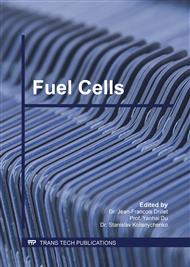p.177
p.182
p.188
p.194
p.200
p.206
p.212
p.218
p.223
Synthesis and Characterizations of Y-Doped BaCeO3 Ceramic for Use as Electrolyte in Solid Oxide Fuel Cell
Abstract:
Fuel cell is an electrochemical cell which converts chemical energy into electricity via electrochemical reaction of hydrogen and oxygen gases. It is also an alternative energy with environmental friendly. Generally, the fuel cell consists of many parts. Electrolyte is an important part for fuel cell because it has high ion conductivity which leads to increase electrical conductivity of the fuel cell. In case solid oxide fuel cell, barium cerate-based ceramics have been much attention due to their good properties for the fuel cell. In this work, the BaCe1-xYxO3-δ (x = 0.20) ceramic was synthesized by a solid state reaction in order to study their mechanical and electrical properties. The ceramic was sintered at high temperature of 1500°C with various soaking times. The crystalline phase structure was investigated by X-ray diffraction (XRD). The surface morphologies was observed by a scanning electron microscope (SEM). The impedance properties was measured by LCR meter. The obtained results suggestes that the ceramic sinter at 1500°C with 15 h dewell time shows the best properties as compared to other ceramics.
Info:
Periodical:
Pages:
200-205
Citation:
Online since:
April 2019
Keywords:
Price:
Сopyright:
© 2019 Trans Tech Publications Ltd. All Rights Reserved
Share:
Citation:



